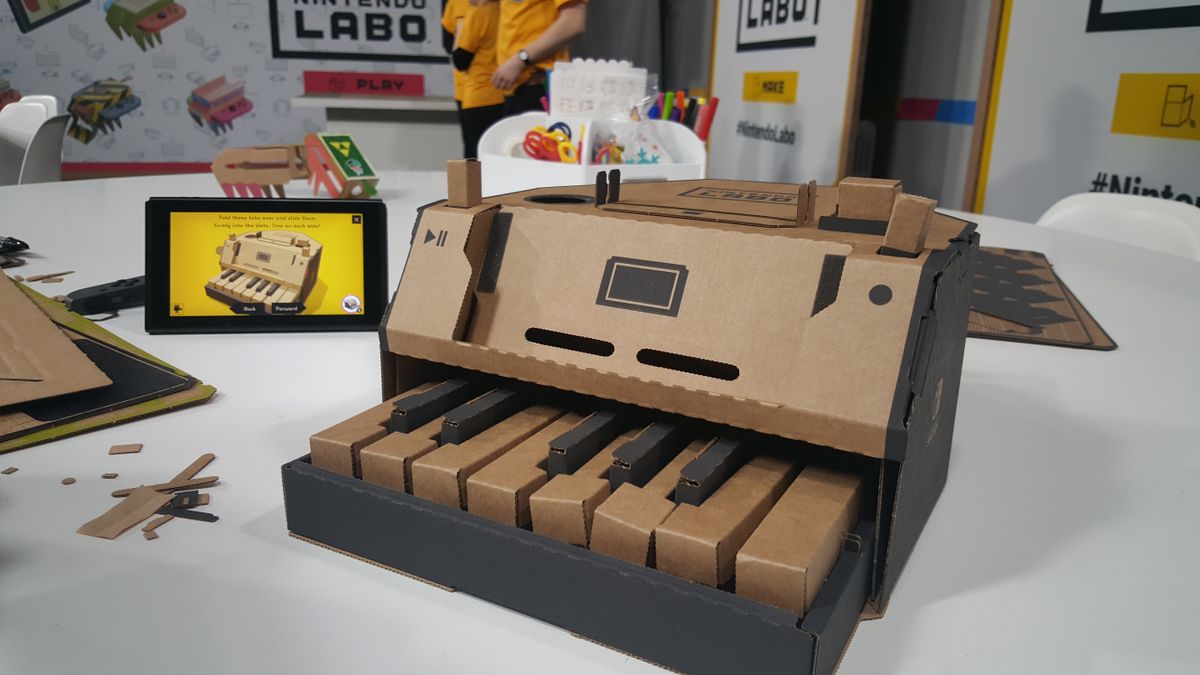Early Verdict
Nintendo Labo is a genuinely innovative release from Nintendo and a great example of how games can be fun and educational. We can absolutely see it providing hours of fun for kids and parents alike.
Pros
- +
Toy-Con Garage has great potential and depth
- +
Construction instructions are good humored
- +
Potential for a global creative community
Cons
- -
No spare parts
- -
Not the easiest to store when you have limited space
Why you can trust TechRadar
Every time someone mentions Nintendo Labo and its cardboard accessories, our minds are called back to one very particular episode of Spongebob Squarepants. In this episode Spongebob and Patrick find an empty box and use it to create magical worlds they can share and enjoy while Squidward is left out of the fun because he lacks patience and ‘imagination’. This is a pretty good summation of what it takes to get the most out of Nintendo Labo.
The clue is in the name: Labo. More than cardboard, Labo is for experimenting and finding new ways to make something work. With this peripheral Nintendo has created a goldmine of creative potential and seemingly endless ways to play, but you’ll have to be prepared to put some effort and imagination in if you’re going to unlock its true power.
How it works
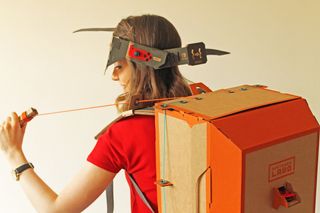
Labo is yet another example of how Nintendo uses simple technology for innovative purposes. On your right Joy-Con you’ll find an infrared sensor, while on each of the cardboard Toy-Cons you build you’ll apply white stickers in very specific places. It’s a combination of the Joy-Con motion controls and HD Rumble, the IR sensor and these stickers which allows all of the parts to communicate and interact, affecting what’s happening on the Nintendo Switch screen.
Upon starting up the Nintendo Labo software you’ll find three sections: Make, Play, and Discover. The Make section contains all of the instructional guides for putting together your Toy-Cons; Play is the place where you’ll find all of the mini games (each Toy-Con has at least one); and Discover is the place where you can dig into how exactly the Toy-Cons and Joy-Cons work and find out how to fix a problem with one if you encounter it. It’s also the place where you’ll find the Toy-Con Garage, but we’ll come back to that later.
Making
You probably already know this, but every single Toy-Con has to be constructed from cardboard. If you’re an adult, IKEA furniture has trained you for this. If you’re a child, this is training you for IKEA furniture.
You’ll find a large number of flat cardboard sheets when you open the box, each of which is color-coded to indicate which Toy-Con it makes, with a letter which you’ll need to refer to when you’re going through the construction process. Some Toy-Cons will also require various eyelets, string and straps and these are included in the box.
It’s tempting to jump straight into the more complex Toy-Cons such as the piano or the racing bike handles but Labo will insist that you start with a basic Joy-Con holder for practice. After this, we recommend kicking things off with the RC car if you’ve purchased the Variety Kit. This Toy-Con will only take around ten to 15 minutes to build and it’s a good taste of what to expect from Labo, without being overwhelming. If you’re jumping straight into the Robot Kit, you’ll probably have been glad of the Joy-Con holder practice. Prepare for a wild ride.
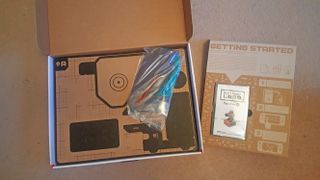
Once you’ve gathered the relevant sheets of cardboard in front of you, starting to build is simply a matter of opening the game on your Nintendo Switch console, selecting the Toy-Con you wish to construct and following the on-screen instructions.
Though we managed to construct the Variety Kit fishing rod cross-legged on our bed, we’d suggest starting things off on a flat clear surface with a comfortable chair; it’ll be easier on your back and will make keeping track of the various sheets and parts far easier.
This is important for a couple of reasons. Firstly, you’ll find yourself discarding a lot of cardboard so it’s a good idea to have a dedicated recycling area. Secondly, there don’t appear to be any spare parts in Nintendo Labo’s kits, which is something of a problem for anyone with a propensity for misplacement. If you fold a piece of cardboard incorrectly (which we did do) or you lose an eyelet, you have a problem, so keep everything organized and in your eyeline.
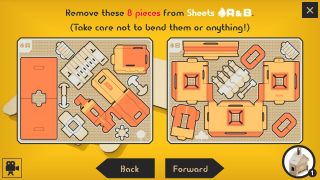
You’ll be glad to know this won’t be like that episode of The Simpsons where Homer tried to build a barbecue; Nintendo Labo’s instructions are very easy to follow and the software makes it clear which sheets you need, how to fold them, and how long the whole building process is likely to take.
The instructions are also far less dry than the standard IKEA fare - there’s a sense of humor to Labo’s instructions and they’re extremely encouraging without being maddeningly patronising. They also suggest good points for taking a break during longer constructions, which we greatly appreciated when it was 11pm and we were only halfway through building the robot, wondering why we weren’t having fun any more.
This is a good example of how the construction process is intended to be a big part of the joy of Nintendo Labo; there’s no point in rushing through building your Toy-Con just to get to the games. To really enjoy this product and make the most of it you have to pay attention to what you’re putting together and revel in the fact that you’re doing it for yourself.
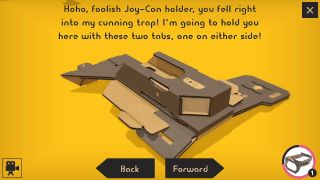
When you actually get into the process, making your Toy-Con is extremely therapeutic. If coloring books and jigsaw puzzles have no appeal for you, we recommend Labo.
If you need more clarity on how a section is supposed to look, it’s possible to use the Switch’s touchscreen to rotate an on-screen 3D model and see it from a variety of angles as well as zoomed in and out. You can also fast-forward and rewind the instructions using either the touchscreen or the Joy-Cons.
The impatient among you may find the ability to fast-forward quite welcome – it’s great that the Labo instructions are so in-depth but sometimes they were a little too much so and we found ourselves fast-forwarding through significant chunks of instructions. When a single Toy-Con has multiple identical parts, being told how to put them together again every time feels somewhat excessive.
When your Toy-Con is constructed, you simply slide the Joy-Cons into it as directed. It’s actually surprising how secure they feel in the cardboard and we weren’t worried about them slipping out and crashing to the floor. Neither were we worried about their weight damaging the cardboard.
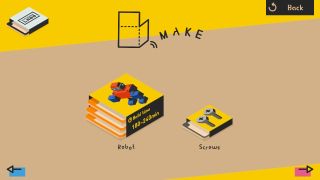
Construction complexity and time varies from Toy-Con to Toy-Con. Before you start building you can see an estimate of how long the project is likely to take so you can be sure you have enough time for what you’re taking on.
Nintendo correctly estimated ten to 15 minutes for the RC car. The fishing rod, on the other hand, could take as long as two and a half hours. We managed it in an hour and 45 minutes and were overwhelmingly pleased with ourselves.
The Robot Kit will take a minimum of three hours. We didn’t hit that minimum - instead we had to split it across two days otherwise we would have lost our booping minds. Once you’re finished, though, you have a wearable robot suit, hand and foot pulleys and all.
We’re definitely predicting speed-runs of Nintendo Labo constructions.
Nintendo also encourages customization of Toy-Cons, and, honestly, we could have spent hours on this alone. Using colored pens, markers, tape, glue and googly eyes of all sizes it’s possible to turn your simple RC car into anything you please.
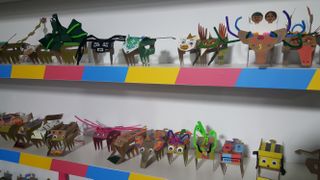
Nintendo will, apparently, release official customization kits in the future that will include Nintendo-specific items. However, these aren’t at all necessary and you can do whatever you please. We’re working on turning our Robot Kit into a Blastoise Pokemon. Watch this space.
Playing
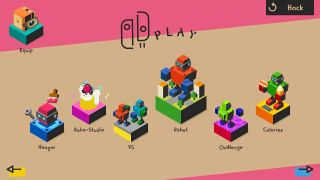
Each kit comes with its own software included in the box, so those purchasing the Variety Kit will be able to access the games relevant to that, and those with the Robot Kit will receive something different again.
In the Variety Kit there are five Toy-Cons and seven experiences, with each Toy-Con attached to a dedicated game, while the piano and fishing rod have two apiece. Labo’s experiences feel much more like mobile games than console games in terms of depth and appearance, but we didn’t really see this as a problem, given the actual construction of the Toy-Cons and eventual experimenting in the Toy-Con Garage is a big part of the fun.
Though the games are simple, they’re afforded an unprecedented level of wonder and engagement thanks to the unique nature of their controls and the fact that you yourself have been involved in their construction.
It’s hard not to get a kick out of a simple fishing game when you’re using a functioning cardboard rod that was built by your very own hands. They also work seamlessly – there’s no delay between your movements and what happens on screen, and we were impressed by just how smooth everything is.

They also have different means of holding your attention: the fishing rod game, for example, is extremely simple but it’s addictive and there are subtleties to catching large fish that you only realise after some experimentation. On the other hand, the doll house mini-game has half a dozen mini-games within itself. Mixing the order of the plug-in accessories that you build alongside the house unlocks different ways to play with its adorable resident and we spent more than an hour moving through these alone.
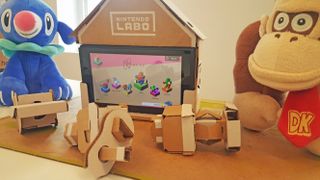
When it comes to the Robot Kit, there is another selection of mini games, all of which revolve around you wearing the suit. The main mini game puts you in an open city as the robot and tasks you with smashing everything you can get your metal mitts on. Using the arm and leg pulleys you can stomp around and punch as the robot. But thanks to the Joy-Con motion controls, when you crouch down you become a gun-equipped car and when you stretch out your arms you can take flight. Controlling your direction is as simple as leaning your body.
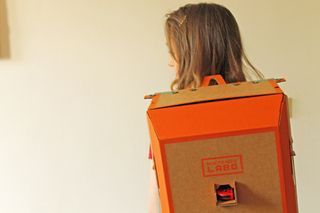
Discovering
Another section worth exploring is Discover. Not only does exploring this section show you how all your work comes together to make a functioning Toy-Con, it gives you advice on how to use them and help with any repairs you may need to make.
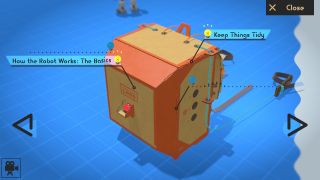
The process of discovery really works across all the sections of Labo: first you build your Toy-Con and understand how it all comes together; then you play with it and see how it performs; then you can dig into how the technology works with an X-ray view. After this you think about how Toy-Cons can be reprogrammed to work with each other and other mini games (driving an RC car with a fishing rod? No problem). The final step is moving away from these games entirely to start creating your very own Toy-Cons and making them interact with one another.
Now we get to what Nintendo Labo is really all about: Toy-Con Garage.
Toy-Con Garage
Toy-Con Garage is the real magic of Nintendo Switch and it’s hidden under a manhole cover in the software’s Discover section.
It’s essentially a simple, and highly visual, cause-and-effect programming experience. You can decide which input you want, choose an action, and then select the output result of that action. For example, you can take the left Joy-Con as an input, decide you want shaking it to be the action, and say that will then cause the right Joy-Con to vibrate or make a sound.
The first stage of using Toy-Con Garage is to make your existing Toy-Cons do different things or interact with one another. You can, for example, use the fishing rod to drive the RC Car with the right mix of inputs and outputs. Or you can make the robot suit emit different sounds depending on which extremity you move or what direction you move it in.
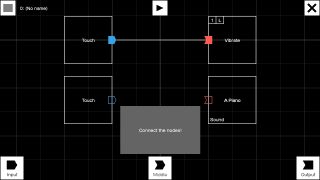
It’s possible to take the most seemingly simple actions to new depth. We’ve all seen Labo man and how it’s possible to use one Joy-Con to make the other attached to his back vibrate and make him fall over. However, you can also program it so that the Joy-Con attached to his back makes a comic sound or a crash as he falls. It’s completely up to you.
After this, it seems Nintendo is expecting people to start coming up with their very own creations. We’ve seen examples of this already: money banks, vending machines, guitars. We imagine it will only be the most dedicated and imaginative of Labo users that will get to this point but the potential for an engaged community is huge and quite exciting to imagine.
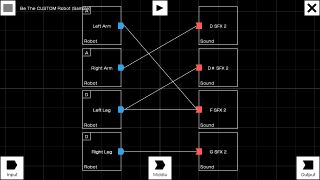
We’re sure that Nintendo will eventually bring out more kits but in the meantime it’ll be interesting to see what Labo users can come up with themselves. We can already picture entire forums dedicated to dreaming up new Labo constructions and sharing plans to bring them together. Developers often say that they’re impressed by what fans can come up with when using mods. This is just another example of that and it’ll keep the Labo software relevant long after its mini games stop being interesting.
Durability and longevity
Given they’re made from cardboard we did have some reservations about just how much use the Toy-Cons could handle before ripping or bending beyond repair.
If you’ve watched Toy Story 3, you’ll know that kids aren’t exactly delicate with their toys and given that the Variety Kit costs $70 / £59.99 / AU$100 while the Robot Kit costs $80 / £69.99/ AU$ 120 these kits aren’t exactly cheap toys to throw around.
In our time with Labo, the cardboard felt impressively durable and it was comfortable to hold. Repeatedly aggressively shouldering on the backpack of the Robot Kit didn’t seem to have any kind of impact and we even took these things on the London underground during rush hour and they looked better than we did by the end of the experience.
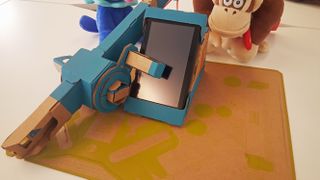
But we do think it’s inevitable that the cardboard will undergo some kind of wear and tear over time, whether it’s a natural deterioration or an accident at the hands of an excitable child.
You would hope that if children have made and customized the Toy-Cons themselves they’d have a sense of pride and ownership towards them that would encourage care. Of course, this means that in the event of an accident, despair has the potential to be tenfold.
In light of, this we recommend storing your Toy-Cons with care. This does, however, pose another problem: space. When the entire Variety Kit or the Robot Kit is fully constructed, it does take up some space.
When you live in a small flat or house that’s not entirely ideal, especially if you have the rest of your child’s toys to contend with. The Toy-Cons can certainly be deconstructed and rebuilt, but doing this every time you wish to put them away is far from sustainable and we think it’s unrealistic to recommend given there’s still a robot suit lying at the bottom of our bed.
We liked
Nintendo Labo is definitely as much about making as it is playing, and we really enjoyed the fact that it's possible to get hours of fun out of it before you even start playing the games. The technology behind the kit isn't overly complex but it's accessible as well as extremely smooth and efficient.
Labo could easily have been a dry and dull piece of software but with its personality-filled instructions and bright and colorful visuals, it avoids this entirely.
We’re also excited about the potential of Toy-Con Garage – not only does this mode have great educational potential, it encourages creativity and greatly extends the life of any Nintendo Labo kit for those willing to dig in and experiment.
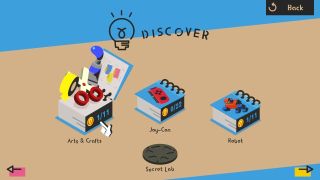
Rather than having children sit quietly with a Switch console, Nintendo has developed something that allows them to feel directly involved in the creation of the games they play. It’s the kind of digital toy which could be a great way for parents to spend time with their kids.
Labo’s experiences are simple but we imagine kids will get a kick out of having been part of the process of making them happen because we sure did. It fosters a kind of immersion and investment that virtual and augmented reality have no hope of beating right now.
We disliked
Though we’re still hesitant about the long-term durability of the Toy-Cons, thus far we’ve not found that to be our main concern with Labo.
What we’re more concerned about is the amount of room they take up and the fact that they could potentially pose storage problems for those living in small spaces. Not only that, the lack of replaceable parts included in the boxes strikes us as somewhat short-sighted, particularly given these kits are intended for children.
Final verdict
While we have to admit we’re more on the Squidward end of the patience and imagination scale, we still had a great deal of fun with Nintendo Labo. It’s hard not to delight in the sheer novelty of these cardboard creations. But we know that if we’re going to keep going back to it, we’re going to need to start digging into Toy-Con Garage.
We don’t think this is a Nintendo product with unquestionably universal appeal though. It takes a particular patience and willingness to create to enjoy Nintendo Labo and even then imagination and a sense of discovery are required to take it further. We hope that for kids, however, it’ll foster these qualities because as much as it’s about play, Labo has a great deal of potential when it comes to learning.
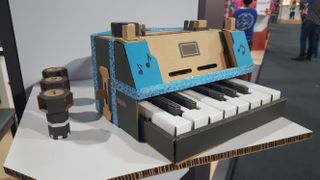
Creativity and problem solving skills are definitely engaged and developed here and, honestly, we can’t help but wonder if Nintendo is quietly creating the next generation of game designers. It’s like an early introduction to the thinking processes behind programming – while many games have us learn their mechanics to successfully play, in some ways Labo has us play to learn more about mechanics.
Even if kids don't dig into to Toy-Con Garage, they could uncover an interest in art or music with Labo.
Certainly, we can see a lot of educational potential with Labo and we don’t think it would look out of place in classrooms, particularly when the programming features of Toy-Con Garage come into play. It’s guerilla education.
Though there’s a lot of focus on the clever cardboard Toy-Cons, cardboard is only a very small part of Labo. Nintendo has crafted an engaging and exciting bit of software here and we can’t wait to see the community that will inevitably form around it.
Note: As part of our review agreement with Nintendo, we have not applied a star rating to this review.
Price and release date
Nintendo Labo will come to the US and Australia on April 20, while the UK will see it a week later on April 27. There will be two kits available at launch: the $70 / £59.99 / AU$100 variety pack which includes the RC car, fishing rod, house and motorbike Toy-Cons. And the $80 / £69.99/ AU$120 Robot Kit.
Emma Boyle is TechRadar’s ex-Gaming Editor, and is now a content developer and freelance journalist. She has written for magazines and websites including T3, Stuff and The Independent. Emma currently works as a Content Developer in Edinburgh.
Most Popular




